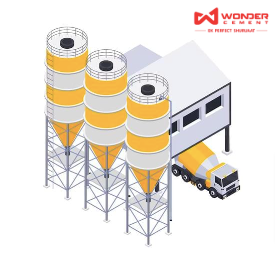Procedure of cement manufacturing in six simple steps
Cement is an essential building material that plays a crucial role in the construction industry. It is the binding agent used to create strong and durable structures. Wonder Cement Ltd is dedicated to providing high-quality cement to meet the diverse needs of the construction sector.
In this blog, we will take you through the six simple steps involved in the cement manufacturing process. We will shed light on cement manufacturing.
Step 1: Mining the Raw Materials:The first step in cement manufacturing is the extraction of raw materials from the earth's crust. Limestone, clay, shale, iron ore, and other minerals are obtained through mining operations. These raw materials are carefully selected to ensure the desired chemical composition of the final cement product.
Step 2: Crushing and Pre-Homogenization:
Once raw materials are mined, they are transported to a crushing plant. Here, the rocks are crushed into smaller fragments to facilitate further processing. After crushing, the materials undergo pre-homogenization, where blending techniques are employed to ensure a consistent mix of raw materials. This step helps achieve the desired cement chemical composition and quality.
Step 3: Raw Material Grinding and Drying:
Crushed and pre-homogenized raw materials are then ground into fine powder in a raw mill. The grinding process utilizes rotating drums and steel balls to pulverize the materials. To prevent excessive moisture content, the powdered mixture is dried using hot gases before moving on to the next stage.
Step 4: Clinker Production:
In the clinker production stage, ground raw materials are fed into a high-temperature rotary kiln. The kiln operates at temperatures exceeding 1400 degrees Celsius, where materials undergo chemical transformation known as calcination. During this process, the raw materials are heated to the point where they form small, dark grey nodules called clinker.
Step 5: Cement Grinding:
The clinker is then finely ground with a small amount of gypsum in a cement mill. Gypsum is used to regulate cement setting time and enhance its properties. The grinding process transforms clinker and gypsum into a fine powder known as cement.
Step 6: Packaging and distribution
Once cement is produced, it is stored in silos before packaging. The final product is carefully packed in bags or loaded onto bulk transportation vehicles such as trucks or railcars. Proper packaging and handling ensure cement quality during transportation and storage. Wonder Cement Ltd maintains strict quality control measures to deliver a consistent and reliable product to its customers.
Cement manufacturing involves six simple steps, from mining raw materials to packaging. Wonder Cement Ltd follows these steps meticulously to produce high-quality cement for various construction needs. Understanding the cement manufacturing process provides valuable insights into the importance of each stage and the efforts required to ensure consistent quality. As a leading cement manufacturer, Wonder Cement Ltd remains committed to producing top-notch cement to contribute to the construction industry's growth and development. Their commitment to producing the finest quality cement is reflected in their use of state-of-the-art German machinery and innovative technologies like the ROBOTIC LAB.
To learn more, click here.
BUSINESS (B2B) Cement Distributors Concrete Repairs Concrete Slabs Concrete Paving Commercial Building Construction Marine Contractors & Construction Home Construction Companies Bridge Builders & Construction Other Construction Services

